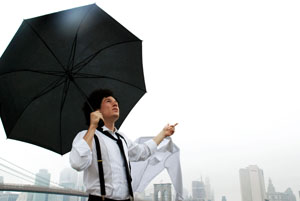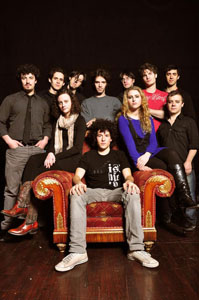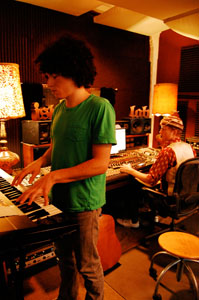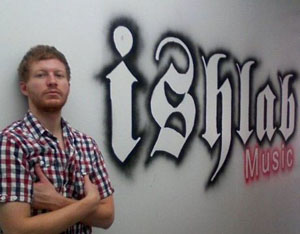Emanuel and the Fear: Out of ishlab, Onto the World Stage
DUMBO, BROOKLYN: It’s such an exciting time in music. Challenging too, yes. But “exciting” because we live and work in a time when bands like Emanuel and the Fear will start as an idea in the studio and become real because there’s nothing standing in their way.
An 11-piece indie-pop orchestra led by singer/songwriter Emanuel Ayvas, Emanuel and the Fear has produced its 19-track debut LP through a unique collaboration with DJ/producer Jamin Gilbert of Brooklyn’s ishlab Music™.
A songwriter and film score composer, Ayvas writes pop songs and arranges them for an orchestra of rock, classical and electronic musicians. Gilbert brings a DJ and electronic music aesthetic to Emanuel’s epic-pop sound. The two have been working together since Ayvas came to ishlab in DUMBO as an intern in ’05.
“After college, I wanted to be immersed in the music business and learn production,” Ayvas explains. “I interned at ishlab for about 9 months and had another band project I was working on in the off-hours. I left to tour with that band, and afterwards, I decided to go out to LA for a while. Right before I left, Jamin had heard some of the new music I was working on and liked it. We talked about doing a record when I returned.”
Out in LA, Ayvas worked briefly as a copyist for film score composer Chris Caliendo. “We were working on these two really big remakes of John Ford films and I got the chance to watch him work,” Ayvas notes.
“We spent a few days at Capitol Records doing orchestral sessions. And that’s what gave me the idea to do an orchestral band. Musically, I loved the idea that I’d be able to be more expressive, more complex and symphonic, but also it was a way I could always control the way things sounded, and I wouldn’t have to worry about replacing players or finding fill-ins. I could just have other and even additional players come, read the score and sit in with us.”
Returning to Brooklyn, Ayvas and Gilbert got right to work on a demo, and Ayvas gradually assembled a band. The first Emanuel & the Fear show with full band happened in January of ’08. In the two-and-a-half years since, Emanuel and the Fear produced a critically-acclaimed EP, which came out in January of ’09, and then the forthcoming LP, Listen, which comes out March 9 on Brooklyn’s Paper Garden Records.
The culmination of many days and nights in ishlab’s Music Lab — equipped with a vintage MCI console, Pro Tools, Logic and loads of analog processors and vintage synths — Listen is a sprawling orchestral pop record that, at its peaks, feels about-to-burst it’s so densely layered, but also goes introspective in quiet, sparser moments. The dynamic arrangements blend rock, orchestral and electronic elements to the point where it’s really almost equal parts of each. When it’s big and anthemic, you hear the Polyphonic Spree and Arcade Fire influences while other tracks run on more minimalist electronic sounds and often build to blends of classical and eastern European instrumentation, 80s synths, and/or epic rock.
At the center is Ayvas’ vocal, the most dulcet and reliable of all the tones, a narrative, sometimes-conversational voice always telling a story you want to hear.
ORCH-POP SONGWRITING, ELECTRO PRODUCTION
Ayvas and Gilbert explore a variety of musical and sonic ideas and styles on Listen. The upbeat single, “Dear Friend” cues some of what’s in store on the record — sunny melodies, full orchestration to film score proportions, Ayvas’ grounding vocal, with the occasional electro sheen perfecting its omniscient storyteller tone. Listen to the album single, “Dear Friend”: Listen to the album single, “Dear Friend.”
Throughout Listen, Ayvas’ voice balances warmth and objectivity, and it’s always up front, as so many other voices and sounds join in and retreat. The vocal is the tying line throughout the record’s various musical exploits, as Emanuel bounces stylistically from orchestral rock to introspective electronic, to synth-driven dancey-pop.
Given the current conflux of indie-rock and classical, electronic and folk, the record sounds very modern, a quality Ayvas acknowledges in crediting Gilbert.
“As a composer my influences are pretty classical but I’ve definitely been influenced by rock and electronic artists as well, probably more so, in my songwriting. So, I approach my orchestration from a classical perspective, but there’s always that strong influence and desire to make things sound like ‘now.’ And that’s something I developed in the last few years, working with Jamin at ishlab.”
Jamin Gilbert’s electronic influence can be heard in both subtle flourishes and driving passages throughout Listen. “My approach is more DJ style — loops, beats and synths, drum machines. But growing up I listened to all kinds of music — rock and jazz, classical, soul and funk so that’s in me, but the way I approach the production is more from a DJ point-of-view. And, with Emanuel, they’re all blending together so it’s been a really interesting collaboration, an interesting balance of skill sets.”
This balance is especially potent in tracks like “Jimme’s Song” and “Trucker Lovesong,” where a tripping beat and synthetic percussion underscores a sparse piano part. “’Trucker’ began as a song on piano and I also wrote a score for it,” says Ayvas. “At first, it was two minutes of just piano and voice, and it was pretty, but started to get boring. Jamin had some ideas: let’s put some beats on it. I was totally resistant at first, but he encouraged me to try it and it really ended up coming together and taking on this Kid A kind of feeling. It actually fit very nicely with the song.”
Pointing around ishlab, Emanuel describes a kind of kitchen sink approach to production on both “Trucker Lovesong” and “Jimme’s Song.” “We laid down the scratch track and we’d sit in here and try all kinds of sounds,” says Ayvas, of “Trucker.” “Jamin would go into the live room and beat-box and I’d be recording my feet shuffling on the floor of the control room, and playing around with some of the synths. It was a long process of sound selection that happened afterwards.”
MIXING LISTEN WITH PATRICK DILLETT
By the time Listen was ready to be mixed, Ayvas and Gilbert felt way too immersed in the project to mix it themselves at ishlab. “We really needed distance from it,” says Gilbert. Ayvas adds, “Plus, it’s so dense — there’s so much going on; if it wasn’t done right, it could sound cacophonous. The dynamics are very fragile. Everything’s kind of swelling, the way it blends between these electronic sounds right up-front and then the acoustic instruments in the room. We wanted someone who could do it justice.”
NYC-based engineer/producer Patrick Dillett came highly recommended via Bryce Dessner of The National. “We heard that Patrick was amazing, and that if he liked the project, he’d do it,” says Ayvas. “I was especially excited about him because he mixed the David Byrne and Brian Eno record, Everything That Happens Will Happen Today, which layers acoustic and electronic elements really well.”
Dillett heard the EP and signed on to mix the record. “As soon as I heard some of the new material, I knew they were on the right track,” says Dillett. “The songs were incredibly dense and sophisticated, but still simple and clear enough to maintain immediacy.”
Keeping the immediacy of Ayvas’ vocal, in particular, in a sea of swelling instrumentation and electronics would seem the biggest challenge. Says Dillett: “On the one hand, this was an easy record to mix. There are tons of elements but the arrangements are sensible in that the instruments stay out of each others’ way.
“But, on the other hand, this was a very difficult record to mix. The balance of acoustic and electronic instruments involved required some extreme measures to allow for the full impact of the songs to be realized. Specifically, more compression on overall mixes than usual, sometimes more radical panning and EQ’ing to open up the sound field and allow parts to breathe while still having a big punchy rhythm section.
“Keeping Emanuel’s vocal completely in control of the story on top of all this was crucial. His lyrics are amazing, and it was vital to me to give people a chance to hear everything and still feel the power of these songs’ productions. Doug Van Sloun, of Focus Mastering in Nebraska, did a great job getting the most out of some pretty radical files. I think the result is a perfect balance of pushing the limits of limiting.”
BEYOND THE STUDIO: iSHLAB iD
Emanuel and the Fear’s relationship with ishlab extends beyond the studio, as the music company also positions the band for opportunities in sync licensing and original composition. ishlab’s music licensing and background music styling divisions operate under ishlab iD, which harnesses the talents of a team of DJs, artists and software developers.
The ishlab iD team comprises music supervisors and stylists, custom-creating playlists for businesses, and designing background and foreground music for restaurants, retail and hospitality environments. Essentially, they create unique soundtracks for brands and commercial environments.
“We’ve developed the ishtech™ proprietary application to allow searches through our catalog, and being involved in producing new music allows us to grow that catalog,” Gilbert points out. “So, the DJing ties in with the production, which ties in with the studio, which ties in with sync licensing and finally, music styling. So, there are many moving parts that all work together in ishlab.”
Gilbert describes music styling as, “remote DJing, for clients from hotels to fashion shows to bars. We are DJs — who knows how to choose music for people better than a DJ? So, there’s are two parts to our magic: the human element of our team being DJs that gives us an edge, as well as our technology side. We can build and deliver custom playlists to businesses using an online platform.”
On the sync licensing side, ishlab represents several artists including Emanuel and the Fear, Betty Black and Leo Coltrane, for opportunities in television, commercials, film and video games. Ayvas sees the connection to these alternative revenue streams as critical to sustaining the band project.
“Our music lends itself very well to picture because it’s so cinematic, so I’m absolutely looking at licensing and original composition as a great opportunity for independent artists like us,” Ayvas shares.
“It’s really important, as people in the music business, to be thinking about how we’re going to keep ourselves going, especially when there are so many people involved. The bottom line is, there has to be money coming in. But I’m also looking forward to licensing and original composition opportunities because I think it will enhance Emanuel and the Fear from an artistic perspective as well. It’s another form of expression and another method of exposing us to a new audience. Plus, I personally really enjoy working with picture — I like working with directors and meeting their vision with the music that’s in my head.”
TOURING: MAKING FRIENDS AROUND THE WORLD
Emanuel and the Fear’s record release show will be at Gramercy Theater on March 10, and will feature members of the NYU Symphony Orchestra. While Emanuel is officially an 11-piece band, it will expand and contract to suit occasion and venue.
“The good thing about this band is that we can do it with six people and it sounds great,” says Ayvas. “So, when we tour Europe in April, we’ll hire orchestra players from the Universities in each city. Take them on and make friends all over the world!”
For the record release show, Emanuel and the Fear will be composed of 25 people on stage, playing Listen as well as an orchestral piece Ayvas has written especially for the event. In March, Emanuel will also play Maxwell’s in Hoboken, World Café Live in Philadelphia, and a bunch of dates at SXSW.
Listen to Emanuel and the Fear at http://www.myspace.com/emanuelandthefear, and see them live at Music Hall of Williamsburg on 2/27/10 or Gramercy Theater on 3/10/10. For more on ishlab Music, visit http://www.ishlab.com; for more on Paper Garden Records, visit http://www.papergardenrecords.com.










